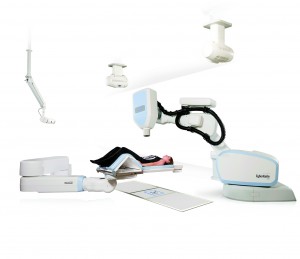No Respiratory Gating or Breath-Holding with CyberKnife Treatment
Tumors in multiple areas of the body can move even a couple of inches just from breathing and the normal internal motions of the body’s organs and fluids. This presents a problem when treating these tumors with radiation since movement can cause damage to the surrounding healthy tissue.
To minimize the risk of damage, different techniques are used in traditional radiation therapy. These techniques are:
- Respiratory Gating: This technique involves the use of software and imaging technology to monitor the tumor’s movement and attempt to predict the breathing patterns of the patient. This technique is meant to help the radiation oncologist synchronize delivery of the radiation to prevent damage to surrounding tissue. However, any sudden movements, such as a cough or an itch, require treatment to be stopped.
- Breath Holding: This is a simple technique used to block air flow for short intervals. Patients are required to hold their breath for 20–30 seconds, which can present problems for patients who have a hard time holding their breath. Holding your breath for repeated intervals can also be difficult. Human error always plays a role, and the accuracy of the breath-holding technique is not guaranteed.
- Abdominal Compression: This technique uses an external abdominal compress to attempt to minimize tumor movement during treatment. This device can be uncomfortable for patients and can cause anxiety for many. The compression equipment uses a pressure plate just under the rib cage that is controlled by a scaled screw to apply different amounts of pressure.
These techniques serve their purpose and can be effective for some patients. However, they do present problems for certain patients such as the elderly, the young, and those with anxiety or other health concerns. These techniques can also be uncomfortable.
CyberKnife: The Non-Invasive Solution

The CyberKnife System offers another option for radiation therapy that can adapt to patient and tumor movement without gating and breath-holding techniques. This treatment is noninvasive and uses advanced robotic technology to deliver highly-focused beams of radiation from many different angles.
CyberKnife is the only radiation system that can track the movement of tumors during treatment to minimize exposure to surrounding healthy tissues and organs. The highly advanced software uses image guidance to follow movement and verify the correct target before delivering the beam of radiation.
The CyberKnife system was originally developed to treat brain tumors. The treatment can be used as a standalone treatment or in tandem with other cancer treatment options, such as chemotherapy. The FDA-approved CyberKnife for the treatment of multiple cancerous and noncancerous tumors in 2001. Some of the cancers and tumors CyberKnife can treat include:
- Lung Cancer
- Liver Cancer
- Breast Cancer
- Prostate Cancer
- Head and Neck Tumors
- Pancreatic Cancer
- Metastatic Cancers/ Lesions
- Spinal Tumors
If you live in Phoenix and are seeking cancer treatment contact us at Phoenix CyberKnife & Radiation Oncology Center to learn more about the most advanced radiation treatment option. We have many board-certified oncologists who are ready to work with you to find the perfect plan for treatment.
